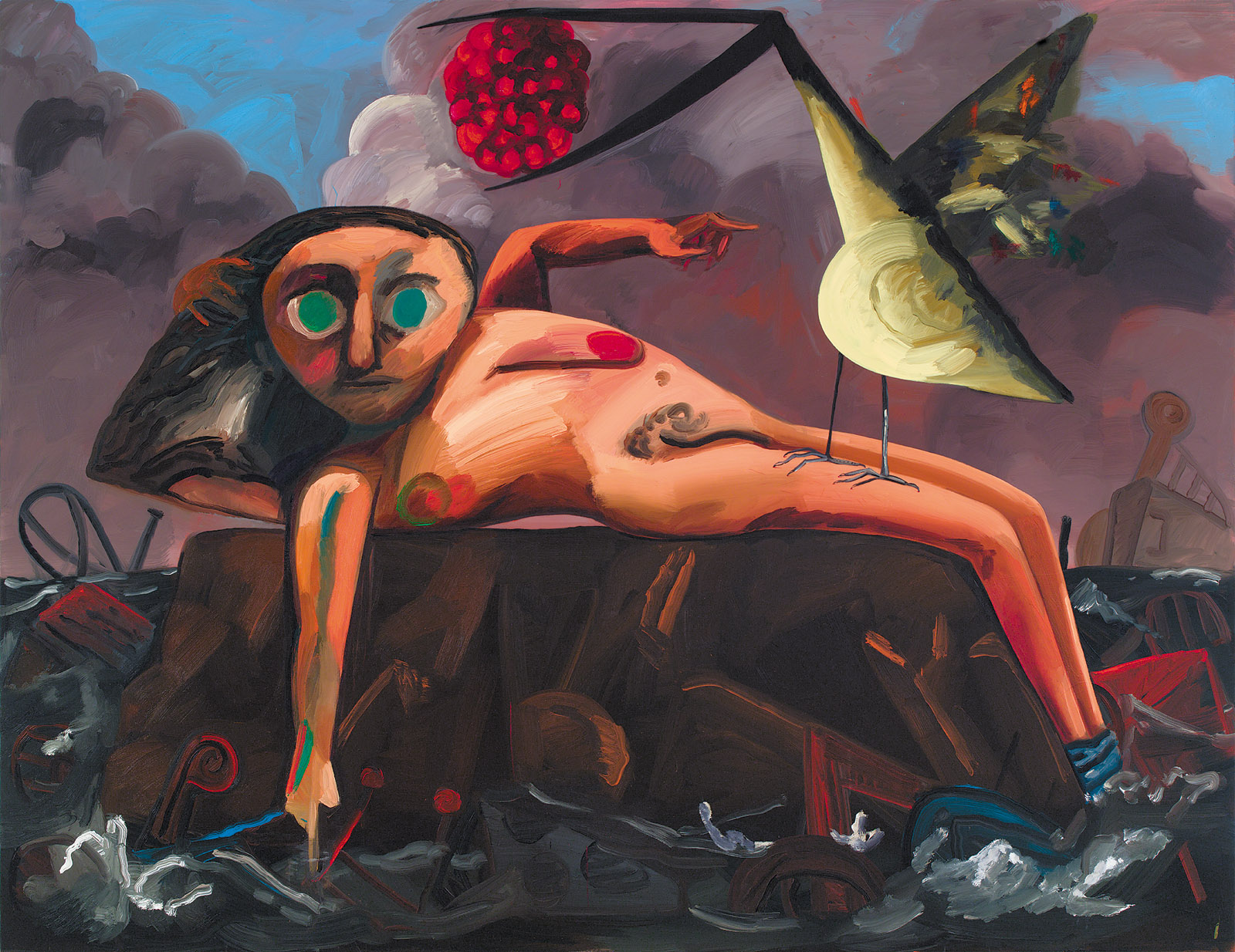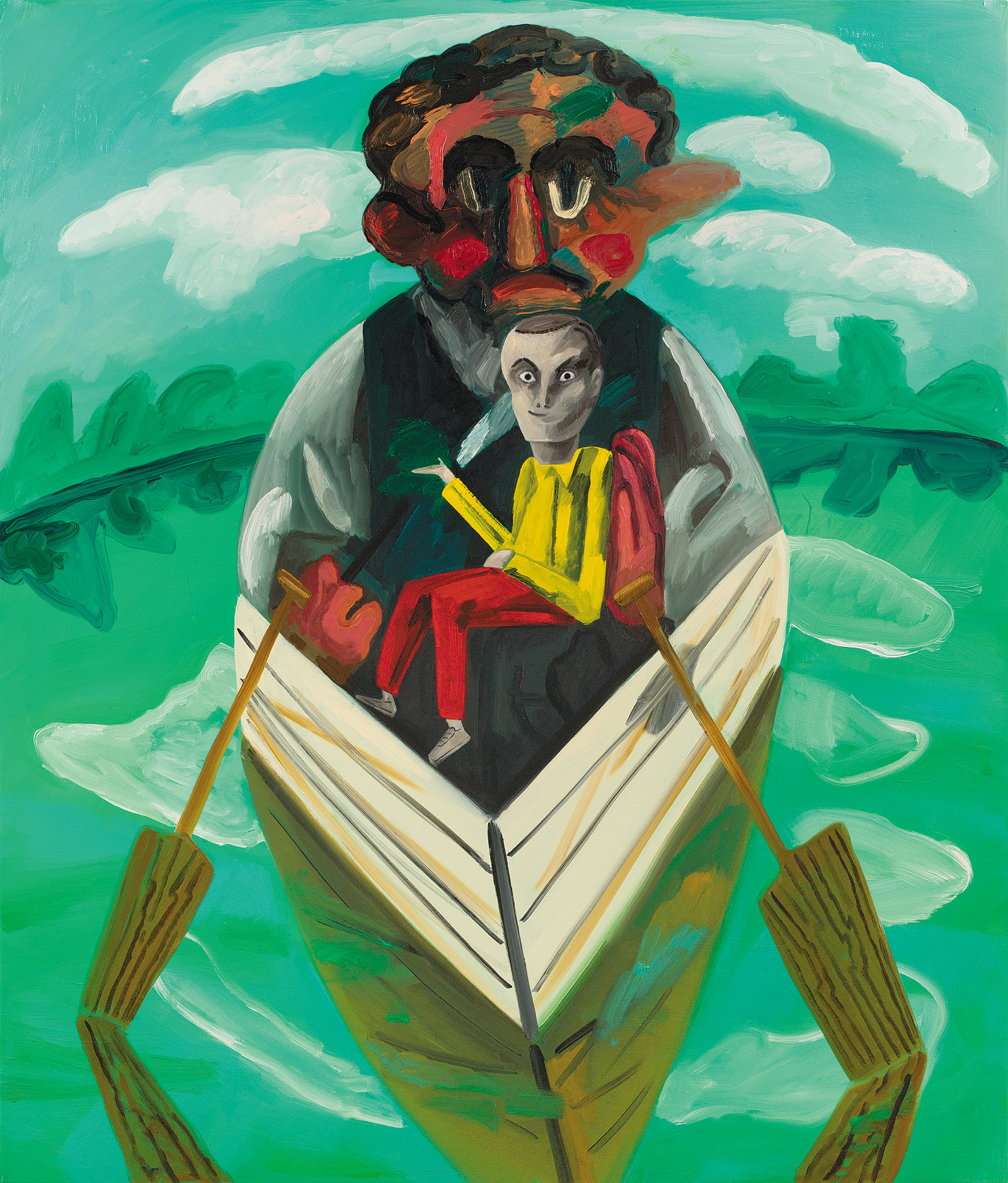Many of the paintings in Dana Schutz’s extraordinary recent exhibition of new work are on the face of it preposterous, even grotesque. In The Visible World, which like most of the other canvases and the bronze sculptures in the show is dated 2018, a nude woman with big, flat, gargoyle eyes is languidly stretched out on a rock at sea, unconcerned about the huge storm clouds gathering behind her. She isn’t unduly bothered either by an immense bird, possibly an albatross, that is standing on her thigh and holding in its beak a raspberry the size of a basketball. In Boatman, a little white rowboat in a green, watery setting is making its way toward us, carrying a man with a strangely formed, darkened face and a misshapen ear and, on his lap, a devilish puppetlike character, a kind of scary Pinocchio (see illustration on page 38).
Set in a washing machine (a first for me), Washing Monsters presents an apprehensive fellow in a suit who may be a monster himself and who is accompanied in the cycle by an actual monster or two and rising soap bubbles. Also a first, Treadmill gives us someone on an exercise machine who is clearly on overdrive and has come to resemble a fish or a steamed lobster. The strangely powerful The Wanderer shows an omnipotent-seeming and somewhat frightening babyish person—most of Schutz’s figures are larger than life-size—who clutches an umbrella and is wearing only jockey shorts and what might be an Apple Watch on his ankle.
Part of what makes these paintings not grotesque and yet difficult to pin down is that the scenes are gently atmospheric. There are not many hard or sharp edges in them, and the sensation of a permeating soft airiness—of all this strangeness taking place in a realm that is dreamy yet real—undercuts what might initially appear expressionistic or ghoulish. There is, rather, a human warmth to these works and, given their impressive sizes—The Visible World is over eleven feet wide and it is not the biggest—a grandeur, too. We can forget that we are looking at monsters or oddities.
With its vamp on a rock, The Visible World might seem at first like a send-up of an image by Théodore Géricault or Eugène Delacroix of survival at sea. There is unquestioningly something ridiculous about her big, unmatching green eyes and her absurd bird companion. Yet her Bette Davis–like persona is merely one of several lively elements that hold us—details such as a suggestion of a face on a nearby rock, green ring-like shapes rising from the sea, and the sketchiest image of an advancing steamship. In other pictures we stop before small passages in rich colors on faces, or that might represent drops of sweat, or perhaps stand for nothing in particular. They all add a welcome sense of paintings taking their final forms before our eyes.
Epical, comic, and a little nightmarish, on easy terms with both treadmills and French Romanticism, Schutz’s canvases add a new note to current art, or at least to the art of painting. They certainly make for a new chapter in the artist’s work. In them she has leaped over everything she has done before.
Now forty-two, Dana Schutz has been exhibiting for almost two decades, since right after she left graduate school. She is a distinct figure in contemporary art, mostly because she works with a subject that has seemed to be hers alone. It might be put as “What would it look like?” Although she is hardly predictable or obvious in the ways she goes about it, she takes improbable moments or outlandish thoughts that occur to us out of the blue and creates images for them. She has made this theme so much her own that if another artist were to do something like it we might feel that Schutz’s terrain was being stepped on.
Her pictures from when she was getting underway were often strange, ingenious, and funny all at once. (They can best be seen in the notable catalog for her 2011 retrospective at the Neuberger Museum of Art in Purchase, New York, whose subtitle, “If the Face Had Wheels,” is a Schutz in words.) Did you ever want to know what a cold looks like? In the unexpectedly beautiful Cough (2001), much of our protagonist, right up through her eyes, is subsumed in different tones of gray, leaving visible her thickly painted whitish lips, which emit a fresh new cloud of gray. Schutz’s early work could make you both wince and giggle. Gravity Fanatic (2005) gives us a character who, not fully believing that gravity can be counted on, has taken string and tape and now seems to have finished securing herself and whatever is nearby to the floor. Gouged Girl, from three years later, presents someone from the back, on a beach with some food beside her, who has had big chunks of her head, shoulder, and torso eaten away, exposing a gnawed red (but not very bloody) interior.
Advertisement
What gave these pictures their life was the robust and seemingly spontaneous way they were painted. Especially in the pictures Schutz did in her later twenties, her color had a tropical heat. She made striking paintings in this period that featured a totally naked fellow named Frank, whom Schutz imagined as the last man on earth and probably someone exposed to too much sun. His whole body was a kind of pink-purple, and Schutz continued in this brilliantly colored vein, often building her scenes with yellows, oranges, pinks, parakeet greens, lavenders, and reds.
Like her bizarre situations and her heightened colors, the way she drew forms, whether faces or limbs—or record players, leaves, flip flops, wood beams, or guitars—had an immediately appealing, almost innocent directness. Her drawing had a note of cartoon animation but without the sense of coming from a family of related forms that a cartoonist—or a painter working with the conventions of animation—might bring to the job. With Schutz we did not know from picture to picture how she would make a foot, a sheet, or hair. Her paintings seemed to say to viewers, “This is fun. You can do it.”
Yet in her New York gallery exhibitions in 2012 and 2015, her work was increasingly off-putting. Although her earlier pictures could have the appearance of being made by an untutored artist, Schutz is, technically, a natural and a whiz. She works with a naive straightforwardness when she needs to, but her brushwork indicates that she can excel in any manner. In these later paintings, her figures continued to look like they were stiffly and impetuously drawn, but the compositions were jam-packed with such figures and all manner of accompanying items, and Schutz’s quest was seemingly to make her scenes almost kaleidoscopes of linked elements, with each element having the same presence as every other one.
Many of these works, including Building the Boat While Sailing (2012), Fight in an Elevator (2015), and Assembling an Octopus (2013), are enormous in size and undeniably feats of compositional skill. One appreciates the way Schutz makes the innumerable and often jagged parts of these worlds cohere. Yet in them and in a concurrent series from 2013 entitled God—surely the ultimate hypothetical subject (see illustration on page 4)—Schutz’s art appeared to be manic. She seemed bent on reinventing Cubism. It was hard to care about the figures in these pictures or the stories being told.
There may not be a clear explanation for how Schutz got from the overly busy paintings of this time to her current and more deeply felt work. It might simply have come from a natural evolution in her thinking. But one can’t help wondering if Open Casket, her 2016 painting about the fate of Emmett Till, played a part in this change. Her relatively small canvas was based in part on a photograph of the fourteen-year-old boy after he had been brutally assaulted, and then lynched and thrown into the Tallahatchie River in Mississippi by two white men in 1955. At his funeral back home in Chicago, his mother, Mamie Bradley, insisted on his casket being open, to show how horrendously he had been treated. His face, in the onslaught, had lost almost all semblance of a face.
Schutz was on thin ice in thinking she could make a painting of so volatile a subject, let alone agreeing to show it in the 2017 Whitney Biennial. She was a white person making an artwork, conceivably for sale, of the event that essentially ignited the civil rights movement in the South—and one that decades later remains incendiary and terrifying for anyone to think about. As it happened, the museum and the painting were picketed. Calls came for the canvas to be removed from the exhibition, even destroyed. (The picture was not removed and it was never for sale.) The experience had to have shaken Schutz. In a recent article by Ted Loos in The New York Times, we hear that she made the painting to mark “this monstrous act and this tragic loss” and that she is now “‘guarded’ about the controversy and is most wary discussing her motivations” for creating Open Casket. She sees that making the work “may have been an ‘impossible’ task.”
But all of Schutz’s pictures are about impossibilities, and in attempting to handle Emmett Till’s story she touched down onto a truer, more fraught and barbed level of the “impossible.” And while it feels repugnant to talk about Open Casket in aesthetic terms (because for most viewers there is no difference between the picture and what Emmett went through), it might be noted that in order to make this picture of a person whose face, in effect, had been lost, Schutz needed to lose aspects of her style.
Advertisement
Open Casket did not look like the Dana Schutz paintings we had been seeing, yet it did not represent an entirely foreign idea for her. In a work from 2005 entitled Presentation, in which an enormous person is being buried or exhumed—it is not clear which—and is stared at by a sea of onlookers, Schutz attempted, she has said, to comment on the US government’s policy during the Iraq War of not allowing images of dead American soldiers being returned home. And, oddly, the early painting Cough shows a head where the face is no longer visible.
Whatever effect Open Casket and its reception had on her, Schutz emerged a different artist and a commanding one. In the pictures from her recent show, she made for the first time people and situations that touch us emotionally. We are invited into the minds of a number of her new figures, not something Schutz has done much before, if ever. The nude on the rock in The Visible World may come from the world of burlesque, but her eyes are making direct contact with us, and we feel her to be a psychological entity. She is a kind of blithe being.
The man in a suit in Washing Monsters isn’t looking directly at us, but his apprehensiveness as he turns away is unmistakable. The situation being presented by the two fellows in Boatman is not clear, yet the unsettling mixture of tenderness and impairment conveyed by the battered-looking big man and the untrustworthy sprite on his lap, who both look directly at us, is reminiscent of the photographs that Diane Arbus took toward the end of her life of developmentally disabled people, shot at the institutions where they lived.
And while the title Washing Monsters is lively in itself and bears comparison with earlier Schutz titles such as Gravity Fanatic or Gouged Girl, most of the new pictures have forgettable titles. But nothing is lost by this. These are not works that can be explained by a title. They don’t give us themes or stories that we are asked to figure out. We look at pictures that are ambiguous poetic tableaux on first sight and that remain, despite our absorption in them, ambiguous.
Not all of Schutz’s new paintings are successful. A couple of canvases with gladiators, for example, did not suggest invitingly odd stories, and Schutz’s sculpture, which she was showing for the first time, and which presents the sorts of figures encountered in her paintings, was a little muffled in impact. This may be because of the very crumpled and marked-up surfaces of these pieces, which she clearly wanted. But one work, entitled Buddy, which is of a standing person who has another head, and nothing more than a head, attached to his own, is immediately readable and appealingly weird. It is about a kind of couple, and it dawns on a viewer that a number of the paintings in the exhibition show characters who have a rapport with each other or are wed in some way.
It is not likely that Schutz set out to illustrate this theme, but it is there whether we think about the siren and her bird or the fellows in their rowboat. In the scene in the washing machine, it is lovely to discover after a bit of looking that a big dark-red paw is touching our worried human on his shoulder. The resplendent painting Trouble and Appearance gives us a stocky man who trudges along, stepping in puddles, dragging behind him a little suitcase on wheels—as a butterfly-like being steps out before him. It is a gift from the artist that she leaves us unsure which of this pair is “trouble.”





